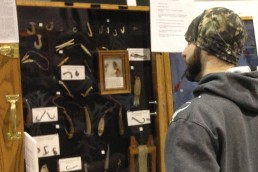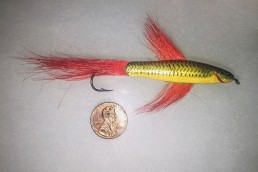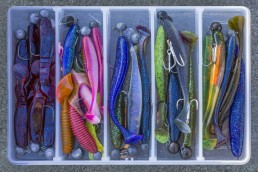Lure Magic
SHARE THIS POST
Fishing is a great sport, as it brings people together from varied backgrounds and ages. Whether it’s helping youngsters catch their first fish, or learning about our history from well-experienced anglers, it’s all good.
Many years ago, we met a most interesting gentleman, Bozdar “Boz” Bulovic. Almost 20 years my senior, he had enthusiasm and experience that continually amazed others and me.
We exchanged fishing tales and interests so varied, yet interesting. We marveled at the evolution of fishing tournaments, early automatic music machines, various collections from his earliest chewing gum collection, to my historic fishing items and our business experiences.
Wonderful visits with our circles of friends revealed great stories of days gone by, including work and play. One of the big surprises he shared was that he had been a lure maker in the 1940s. Working in a machine shop he, like many others in this line of work, had conceived of and produced a lure he believed would be his ticket to a fortune, or at least a comfortable sum of money.
The lures were produced complete with packaging and a catchy name, the Ski Wiggler. Now, to market them. It was difficult to get any business or distributor to even agree to see him to become introduced to his new lure. Finally, a distributor did agree to hear his pitch. “But he hardly looked up from his papers as I extolled the features of my new lure,” Boz exclaimed.
“Then the distributer said something that caused me to shrink in my chair!” Boz proclaimed. He asked, “What kind of demand is out there for your product? It was like being hit with a baseball bat,” Boz reports, “and this was the best lesson on business and marketing I ever received.”
Why would a store or rep carry a product for which there was no demand? He began to get quotes from the national sporting goods publications for an ad to create demand, but the cost was far more than he could afford. What to do with all the inventory he’d produced? He finally thought of the 1947 winter sports show, and scraped up the money for a booth.
How could he create interest and demand? Both he and friend Frank Peters were magicians. They began to construct an act, and friend Campbell Mathie built a box described in an old magic book.
Are you enjoying this post?
You can be among the first to get the latest info on where to go, what to use and how to use it!
As customers strolled the aisle, Boz and Frank made this pitch. “Unfortunately we can’t show you an actual fish-catch on the Ski Wiggler at our booth, but we will prove it’s magical fish-catching ability another way, by demonstrating how you can catch one on every cast. Let us show you.
“This deck of cards will represent a school of fish. The small hole in the cards is the fish’s mouth. You’re going to choose any card, and we’ll call it your Lunker. Here, take any card we’ve fanned out that you wish. Show it to to the group around you, put it back in the deck yourself, shuffling if you want. This solid wood box will be the lake. Look inside. Put your hand in and make sure it’s empty. Now put all the fish (cards) in the lake, and stir them up. Ready? Time to go fishing!”
The customer was handed a rod and reel with a Ski Wiggler lure attached. The box was about 6 feet away, on a 5 ½-foot stand. The attendee would drop the lure in the box (“lake”), then slowly retrieve. As the lure came out, the crowd cheered as the chosen lunker card came out! Many then bought the lures, and as they dispersed, another crowed attracted by the excitement of the observers would gather.
I asked, “But what if the wrong card came out?” “It never did,” said Boz, “It’s magic!”
When younger, we would have pestered until finding out the trick. Was it the box, the card they selected or a combination of ingredients? It’s fun to wonder. But with age comes the realization that, to marvel at a magician’s act is the key to enjoying it.
Boz went on to become a highly-respected executive with Wrigley, as he never forgot the lesson, “There must be demand for your product.” Wrigley produced great advertisements, even in tough economic times, and thrived.
Now it’s even more difficult to come up with a fish-catching lure, and get it produced by manufacturers or sold profitably. They fear that, if you show them a bait, they could be held liable for royalties on any lure they later produced.
MWO
SHARE THIS POST
Did you enjoy this post?
You can be among the first to get the latest info on where to go, what to use and how to use it!
Dan Basore
Dan Basore is a fishing historian and steward of the history of the sport. In his efforts to preserve fishing history, he is always on the lookout for information about early lure makers, old lures, pre-level wind reels, manufacturer catalogs, tournament casting items and the like. If you possess information or materials of this kind, please contact him at 630-393-3474 or by email at ollures@aol.com.



